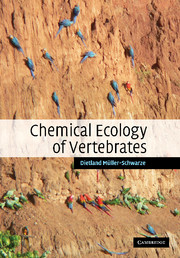Book contents
- Frontmatter
- Contents
- Preface
- Acknowledgements
- 1 The odorsphere: the environment for transmission of chemical signals
- 2 Properties of vertebrate semiochemicals
- 3 Odor production and release
- 4 Chemical cues in orientation and navigation
- 5 Chemoreception
- 6 Signaling pheromones I: discrimination and recognition
- 7 Signaling pheromones II: sex and alarm pheromones and evolutionary considerations
- 8 Intraspecific signals: priming pheromones
- 9 Development of intra- and interspecific chemical communication
- 10 Allomones I: chemical defense by animals
- 11 Allomones II: plant chemical defenses against herbivores
- 12 Kairomones and synomones
- 13 Practical applications of semiochemicals
- Glosssary
- References
- Index
5 - Chemoreception
Published online by Cambridge University Press: 23 November 2009
- Frontmatter
- Contents
- Preface
- Acknowledgements
- 1 The odorsphere: the environment for transmission of chemical signals
- 2 Properties of vertebrate semiochemicals
- 3 Odor production and release
- 4 Chemical cues in orientation and navigation
- 5 Chemoreception
- 6 Signaling pheromones I: discrimination and recognition
- 7 Signaling pheromones II: sex and alarm pheromones and evolutionary considerations
- 8 Intraspecific signals: priming pheromones
- 9 Development of intra- and interspecific chemical communication
- 10 Allomones I: chemical defense by animals
- 11 Allomones II: plant chemical defenses against herbivores
- 12 Kairomones and synomones
- 13 Practical applications of semiochemicals
- Glosssary
- References
- Index
Summary
We might fairly gauge the future of biological sciences, centuries ahead, by estimating the time it will take to reach a complete, comprehensive understanding of odor.
lewis thomas, in: Late Night Thoughts on Listening to Mahler's Ninth SymphonyTo appreciate the possibilities and limitations of exchange of chemical information, the chemical ecologist needs to understand how the chemical senses work. There are a number of outstanding reviews and books on chemoreception per se. In addition to the general principles of chemoreception, the chemical ecologist is particularly interested in adaptations of anatomy and performance to specific abiotic and biotic conditions that optimize signal detection and maximize information gain. Here odor reception will be treated from an ecological viewpoint and only to the extent that it is an essential step in the behavior of an animal moving about in its environment and attending to vital cues. While sensory studies in the laboratory employ simple and clean stimuli, noise and the need for filtering are important factors in sensory ecology (Ali, 1978).
Encounter and exposure: orientation, sniffing, licking, tasting
The ecologist is interested in behaviors that animals employ before odor molecules even reach their chemical sense organs. Animals can manipulate the amount of odorants reaching the chemoreceptors by manipulating airflow toward the receptors, body movements, or locomotion. In its natural environment, an animal may seek or avoid stimulation by odors. Such behaviors cannot be satisfactorily addressed in the confines of laboratory studies. A foraging carnivore or herbivore exposes itself continuously to new chemical signals. Alerted by a sound or visual stimulus, an antelope or deer may turn into the wind and sniff.
- Type
- Chapter
- Information
- Chemical Ecology of Vertebrates , pp. 82 - 123Publisher: Cambridge University PressPrint publication year: 2006



